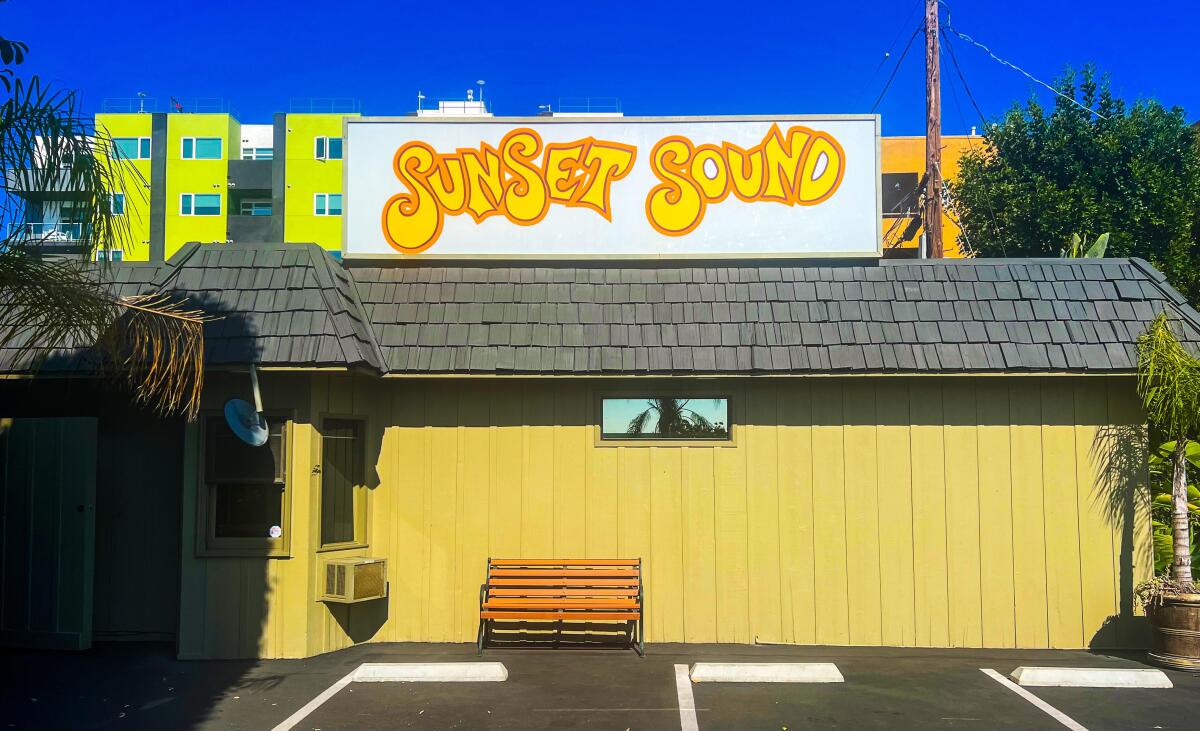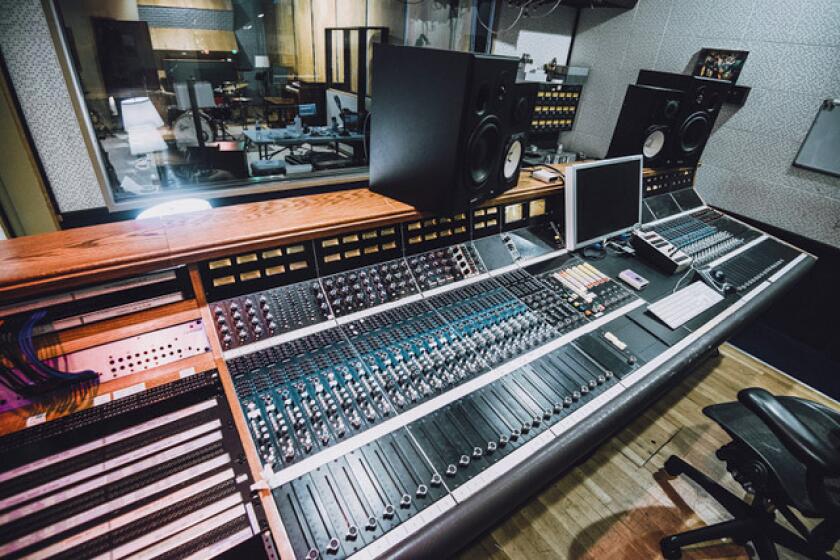Sunset Sound is one of the last great L.A. recording studios. To lose it would be a disaster.

- Share via
There are two ways to look at the corner of Sunset Boulevard and Cherokee Avenue in Hollywood. It is an area with a large unhoused population, and for the past 64 years it has been home to one of the country’s most iconic music recording studios, Sunset Sound.
Now, one truth about this particular bit of real estate threatens to annihilate the other.
According to multiple news reports, Sunset Sound might go out of business because of the dangers posed by a nearby homeless encampment.
The homelessness crisis in large California cities often becomes a scapegoat for the disruptive, divisive chaos of early 21st century life. San Francisco is in an “urban doom loop” because of homelessness, not, say, because of the staggering inequities wrought by rising techno-authoritarianism. Los Angeles neighborhoods are unsafe because they are overrun with homeless people, not because of soaring housing costs enabled by NIMBY elites that push people out onto the street.
Los Angeles boasts the highest concentration of top-notch recording studios in the world. We’ve mapped out 32 of the spaces where SZA, the Beach Boys, Frank Ocean, Neil Diamond and others have made musical magic.
But the problems experienced by those living or running businesses near large homeless encampments are quite real. Sunset Sound’s owner and studio manager, Paul Camarata, has publicly described escalating troubles — a burglary, two instances of arson and discomfort expressed by visiting artists.
Recording studios have, historically, been built and operated in rougher parts of town where rent is cheap and warehouse-type spaces are plentiful; their owners know something about security. This is why Camarata’s cry for help should not go unanswered by city officials tasked with humanely taking care of disadvantaged people in need of shelter, food and health services.
Especially given that homelessness is not the biggest threat Sunset Sound faces. That threat is existential and highly documented: namely, the digital revolution has done to the analog world of art, media and communication what the industrial revolution did to agrarian and handicraft economies a century before. In the case of the music industry, the advent of Pro Tools recording software in the 1990s and the rise of music streaming services in the early aughts — with its cataclysmic loss of income for artists and studios — irrevocably changed the business.
For years cost-effective digital technology has enabled a seismic shift away from the legendary temples of carefully crafted sound that facilitated the creation of some of the greatest records of all time, and into the garages, bedrooms, kitchens and living rooms of indie artists and superstars alike. Making music, once the very definition of artistic collaboration, now more often than not occurs in isolation with a vast library of plug-ins designed to mimic the sounds of various recording studios.
Sunset Sound is among the last holdouts of a once-thriving music-business ecosystem that is taking its last gasps.
If we care about the craft, art, history — and future — of music, its survival should concern us deeply.
Sunset Sound represents the apotheosis of the recording industry’s heyday. It is also a sentimental favorite because it is among the last family-owned old-school studios in a city once awash in them. The state-of-the-art, three-room studio was founded by composer Salvador “Tutti” Camarata, who played trumpet for Jimmy Dorsey and Benny Goodman. In 1956 Walt Disney hired Camarata to form Disneyland Records. Tutti built Sunset Sound for that purpose and eventually recorded audio there for a number of Disney classics, including “101 Dalmatians” and “Mary Poppins.”

For the record:
9:57 a.m. Feb. 20, 2024An earlier version of this story incorrectly spelled Paramore.
The ’60s and ’70s ushered in a golden era of recording in Los Angeles, with dozens of state-of-the-art studios dotting the landscape from Hollywood to the San Fernando Valley. Sunset Sound rose to the top in tandem with bands and artists that recorded there, including Led Zeppelin, the Doors, Janis Joplin, Van Halen and Prince, and later hosted sessions with the likes of Kings of Leon, Paramore, Morrissey and Smashing Pumpkins. The studio now is owned by Camarata’s son, Paul, and boasts more than 300 gold records.
As with most great empires, the beginning of the end for this towering studio system was its decadence, which ballooned to cartoonish proportions in the ’80s and ’90s with soaring studio-time costs, lavish drug budgets and records like Guns N’ Roses’ “Chinese Democracy” and Michael Jackson’s “Invincible” taking years to complete at exorbitant cost ($30 million, in the latter case).
Rapid-pace record industry mergers during that era, as well as the meteoric rise of cheap digital technology, soon eradicated the days when passionate record companies funded years of artist development with only the hope that it might one day pay off (as happened with Prince’s career).
Still, until the past decade or so, Sunset Sound and other local studios remained at the heart of music making.
These monuments to analog craft were physically accessible touchstones for generations of musical artists: those who wrote and performed the music, those who built the studios to rigorous specifications in order to harness the optimum spaces for sound and those who recorded those sounds. Over the years, legions of highly skilled engineers and producers labored to find just the right mic to capture the unique twang of a guitar, pioneered the use of slapback delay and spent untold hours patiently splicing 2-inch tape to make sure a drumbeat was perfectly timed.
Aspiring young music makers flocked to L.A. yearning to work inside the walls where their idols made sacred records, with the hope of one day doing the same. My husband was one of those people in the ’90s — an avid music lover arriving in Hollywood from a small Pennsylvania town and working as a runner at the Record Plant, before moving on to A&M Studios on La Brea (now the Jim Henson Company’s lot). Later in his career, he would work many sessions at Sunset Sound.
As an apprentice to some of the best engineers and producers in the business, my husband learned to become a master of sound himself, eventually going on to engineer and produce for artists and bands like Sean Lennon, Kate Nash, Warpaint and Liars. He has seen firsthand the decimation of the traditional studio model, and with it the community of artists and musicians who learned and created in these rarefied realms where some of the most important contacts were made during conversations on the basketball court or while grabbing a bite to eat in the lounge.
I first became good friends with him when he recorded my indie band on a computer in the garage at his house — my little band couldn’t afford a room at Sunset Sound. I know the great advantage afforded to independent artists by the digital democratization of record-making tools. But I also know what it feels like to step into Studio One at Sunset Sound, where the Rolling Stones recorded parts of “Exile on Main Street,” and to feel the history, connection and power of the place.
If we don’t take care, mine might be the last generation to experience such a thing. All around, music studios are closing. Just last year, United Recording, founded in collaboration between Frank Sinatra and the highly influential recording engineer Bill Putnam and where artists including Ray Charles, Beck, Green Day and Kendrick Lamar made music, laid off its staff and announced it would be renting out the studio for film shoots and special events.
Many would disagree but I don’t believe a plug-in that mimics the reverb inside Abbey Road Studios will ever be the same as the hallowed vibrations of that historic space. And, as a dear friend and music fan recently pointed out, when we no longer have legendary spaces on which to model such sounds, what will we have left? What will be real? A plug-in that re-creates the sound in some famous singer’s bedroom?
If the city can’t rally to protect its own musical legacy, by the time we realize what we’ve lost it will be too late. Los Angeles remains the entertainment capital of the world and it is in our best interest to ensure Sunset Sound’s survival. It also wouldn’t hurt if some of the wealthy celebrity musicians who know its value better than most were to lend a hand. The plight of the unhoused — and those who live, work and make art among them — is everyone’s business.
More to Read
The biggest entertainment stories
Get our big stories about Hollywood, film, television, music, arts, culture and more right in your inbox as soon as they publish.
You may occasionally receive promotional content from the Los Angeles Times.












